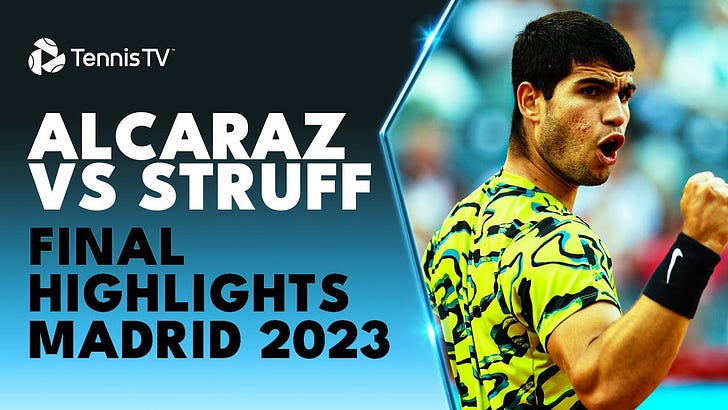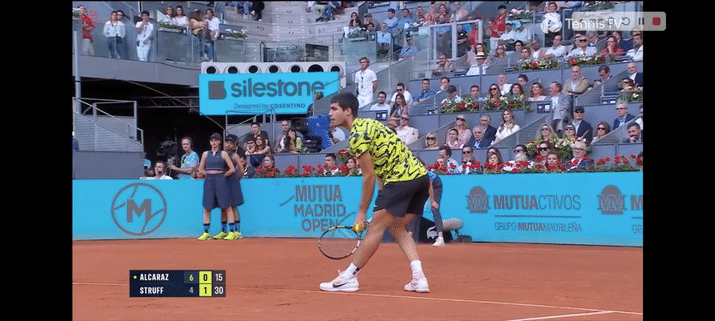Alcaraz x Struff: Madrid Final Analysis
return positions—neutralising Alcaraz—Madrid conditions
Carlos Alcaraz defeated Lucky Loser Jan-Lennard Struff 6/4 3/6 6/3 in the final of the Madrid Masters 1000 on Sunday to defend his title and extend his win streak to 10 matches since his clay season began in Barcelona.1 To Struff’s credit, it was only the second set the Spaniard had dropped in his last 10 matches on clay.
Coming into the final both men boasted strong serving numbers, courtesy of the Madrid conditions playing a little faster through the air. However, the difference in the percentage of return games won highlighted the superior court coverage and return prowess of Alcaraz.

Struff began the year ranked #167 after a poor 2022. However, in 2023 the 33-year-old German has already racked up 34 wins across Challengers, ATP qualifying, and ATP main draw appearances.2 His run to the Madrid final came off the back of some big serving and very aggressive return strategies that have paid off in the quick conditions.
A nervous opening game from Struff where he threw in two double faults gifted the early lead to Alcaraz. In contrast, a confident defending champion made his intentions clear on his first serve from the outset, jamming Struff with a fast body serve to prevent him from getting a swing on the return.
However, Struff made Alcaraz pay twice in the second game when he got the line wrong, highlighting why he was a deserved finalist:

Struff opted to take on the Alcaraz first serve as well. Taking it inside the baseline with a short backswing.
Struff’s aggression paid off in the fourth game as he broke back with more big hitting. An increasingly frustrated Alcaraz struggled to adapt early on to the pace of play and the willingness of Struff to play big from the back and come forward.

Struff would venture forward 52 times in the match, winning 33 of those points for a very healthy 63% win rate. Many times it was off the back of his first serve, capitalizing on Alcaraz’s very deep return position (not dissimilar to what Alcaraz did to Medvedev at Indian Wells in March). The camera angle for much of the seventh game of the first set provided a court-level view of this tactic playing out:

When a player returns from a deeper position like Alcaraz above, there is a tradeoff: they buy more “time” (as the ball takes longer to reach them) yet make the court “bigger” for their opponent (firstly, by simply being further back it opens up the forecourt, but they are also forced to take a wider stance to cover the angled serve). Observe below how far to the right Alcaraz is positioned in order to cover the wide serve. A returner taking a more neutral position just behind the baseline would usually have their right foot intersecting with the singles sideline.

However, Alcaraz also makes the court feel “smaller” to his opponent by virtue of his speed and court coverage. It forces opponents to push for the line. Often they push too hard on regulation shots:
And the added time—especially on second serves—also allows Alcaraz to find more forehands to start (and promptly finish, in this case) return points:
This dichotomy in return positions and tactics was countered by each man with very deliberate serving patterns. Observe the stark difference for first serves on the deuce side.


And their return positions (left side is Alcaraz):




Struff played a tactically smart match today. He knew he didn’t have the movement or rally edge, and he committed to a strategy that gave him the best chance of winning. It also meant he forced Alcaraz into a mode of play he isn’t used to; Alcaraz didn’t venture forward too much or get an opportunity to play many drop shots. It paid off handsomely at the start of the second set, again with some returning that Agassi would be proud of:

Ultimately, while this was a high-risk brand of tennis that neutralized the best defender in the game, there are few players (and to an extent, conditions) that are capable of pulling this brand of tennis off this well. Struff has a big serve, is an accomplished net player with a strong doubles resume, and was absolutely lasering his groundstrokes and returns for the better part of 90 minutes. I can’t think of too many other players who could get in this mindset, let alone execute this type of tennis (Rune, Tiafoe, Kyrgios, and Bublik come to mind3). As Alcaraz said in his on-court post-match presser:
“Jan was really really aggressive. Sometimes I couldn’t play my game, just waiting for my chances…but I told myself I have to be positive all the time. I was going to have my chances, and I think I did in the third set.”
A graph from Twitter user Vestige_du_jour highlights the reduced forehand topspin of players in Madrid compared to Monte Carlo last month:

While Struff’s pressing gameplan thwarted Alcaraz’s ability to use the drop shot, by my count Alcaraz still won 6/7 points when he did use it, with 4 of the 7 attempts coming from his less common backhand wing. His ability to execute under pressure is ridiculous. This one below came in a huge moment early in the third that helped him secure the pivotal break point. If he misses it, he’s a fool. If he makes it, he’s a genius:
A look at the rap sheet:

By my count using my proposed metrics:

I think it’s important to recognize that Madrid has some unique conditions that don’t really reflect what conditions at RG will be like in a few weeks’ time, so with Rome around the corner, and with Sinner, Djokovic, and the rest of the top-10 in the draw (although still no Nadal), it should give us a good picture of how this year’s clay slam is shaping up. A look at the top 10:
I’ll be back during Rome with some more match analyses.
Struff lost to Karatsev in the qualifying draw of Madrid, then defeated him in the semi-finals of the main draw. A peculiar aspect of tennis is that you can win a tournament having already lost in it, as Struff nearly did today.
Struff has always been a dangerous prospect in tennis, posting a 12-33 record against the top-10 in his career prior to the meeting with Alcaraz.
Cressy kind of embodies this level of aggression without necessarily having the forehand or backhand competency of Struff though.











Regarding the high forehand UE rate from Alcaraz, I feel that he was misplaying baseline exchanges for most of the first two sets. It's natural to have a rough patch with a shot ocasionally, but he did not need to gamble so much against a player like Struff whose shot quality degrades with movement to a larger extent than your average late-stage clay court tournament opponent. He would have benefited from greater patience on the rallies, not just through improving the win rate from the baseline but also by letting him hit more balls and gain more feeling on the ball. By the third set he had finally realized that he would easily win the baseline trades as long as he did not miss a winner / decissive shot attempt, as he had done earlier in the match.
Struff did well on the tactical side considering his toolbox, he just struggled a bit with landing enough first serves (particularly in critical games in the first and third sets) and had a few inconvenient setbacks with the volley (even though overall he did well on the net).
Thanks Hugh, great piece as always! Two questions in one:
1. I guess this agressive return strategy and rush forward tactic on serve only applies to those who know they can't hold the baseline against Carlitos but want to rush him anyway, right? So Sinner, Djokovic (who both adopted mixed return strategy against him, but I would say they were neither deep nor agressive - sinner rushing on second serves tho) and, I believe Rune because of his incredible fundamentals, because their return are so good they can just play it deep and then apply pressure during rally ?
2. Jan Lennard Struff : purple patch, right? His technique reminds me of Berrettini's, which is great on the forehand side - he hammers it too and can abbreviate it well as we saw - , but not that much on the backhand side, and I can't really see it become a consistent/reliable shot. Anyway, hope a can be a good dark horse for the french, even though conditions will favor him less